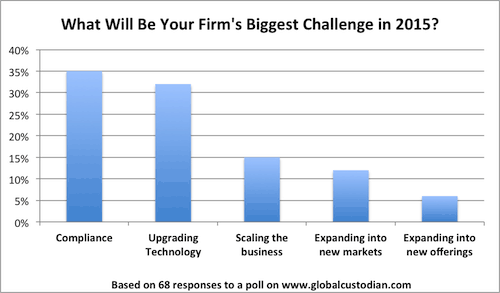
Based on the poll’s 68 responses, 35% said “compliance” was their top challenge for 2015, and 32% selected “upgrading technology.” Meanwhile, only 15% picked “scaling the business,” 12% chose “expanding into new markets,” and 6% answered “expanding into new offerings.”
This distribution of results could be attributed to the interlinking of compliance and technology recently and that these are two top-level issues that then pave the way for the other three areas addressed in the poll.
“Our clients’ challenges are a function of their operating environment. That environment is characterized by a steep increase in worldwide compliance requirements, fiduciary challenges, and an explosion of alternative assets in their portfolio composition,” says Griff Ehrenstrom, head of the Corporate & Institutional Services consulting division of Global Product & Strategy at Northern Trust. “These dimensions are not mutually exclusive, and the GC survey elements not cited directly among them fit easily within this context.”
For example, the growth of alternatives can mean more compliance and technology requirement, and service providers can then expand into new offerings.
“Instruments such as OTC derivatives, hedge funds, and private equity are critical components to clients in an environment of low interest rates and funding challenges. These assets require new data to properly value and create performance,” says Ehrenstrom.
“For example, proper valuation for OTC derivatives obliges custodians to seek new data for terms and conditions, and partner with specialists for particularly arcane investments,” he says. “Tracking capital ratios for an investment portfolio of dozens, or even hundreds of private equity investments is a record-keeping challenge with which custodians have plenty of analogous experience, but still requires a build to provide effectively.”
Jordan Schwartz, partner and managing director at Cordium, a regulatory compliance consulting and software provider, says that he’s also seen more overlap between compliance and technology at alternative asset management firms, particularly as it relates to cybersecurity.
“A lot of our clients’ compliance teams are the ones being tasked with handling the cybersecurity initiative, and a lot of the times they’re not [originally] technology people, so there’s becoming a lot more overlap, and we’re seeing a lot more compliance people becoming knowledgeable in the IT area to at least spearhead the initiatives.”
Asset managers will still outsource many IT functions to service providers, he says, but compliance personnel need to be up to speed on technology changes, because if the Securities and Exchange Commission (SEC) ever audited the firm, for instance, the compliance team would be responsible for making sure everything’s in order.
And Schwartz adds that while investment managers have become more comfortable with outsourcing to cloud-based tools, firms have also realized that they need to do more due diligence when working with service providers.
In all, though, 2015 looks to be a promising year for third-party technology providers, as a recent study by Celent estimates that while internal IT spend at North American banks will stay flat this year, while spend on external software will grow at about 8%. In Europe, internal IT spend will rise about 1%, while external software spend will jump over 12%.
“The growth represents the backlog of required investments as much as it does preparations for the future,” says the Celent report.
Editor’s Note: Please answer our latest poll on outsourcing, which can be found on the top left corner of our home page.